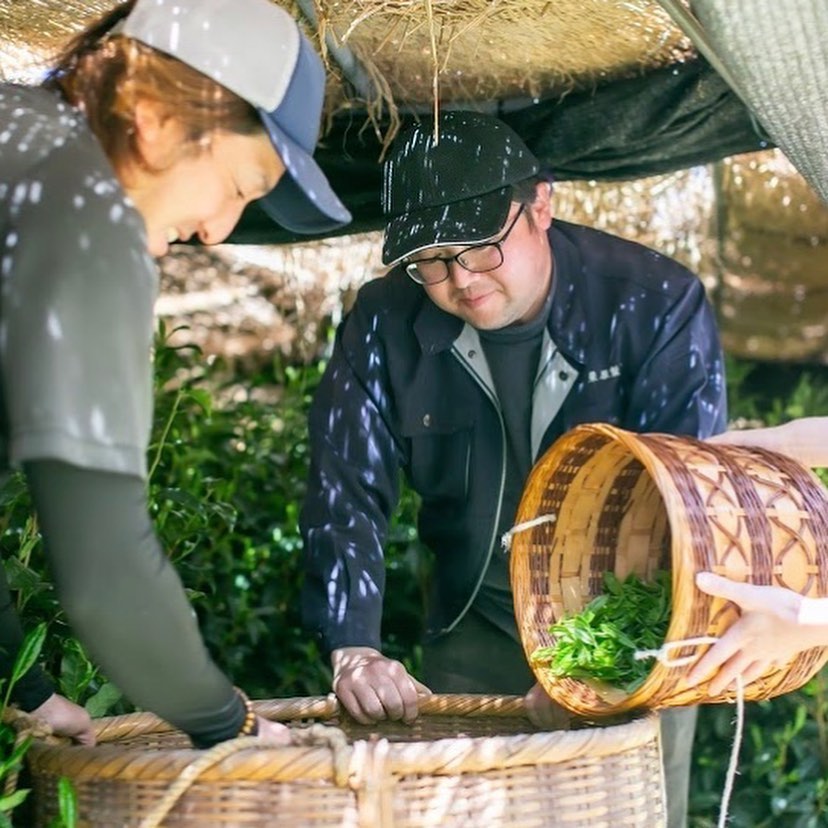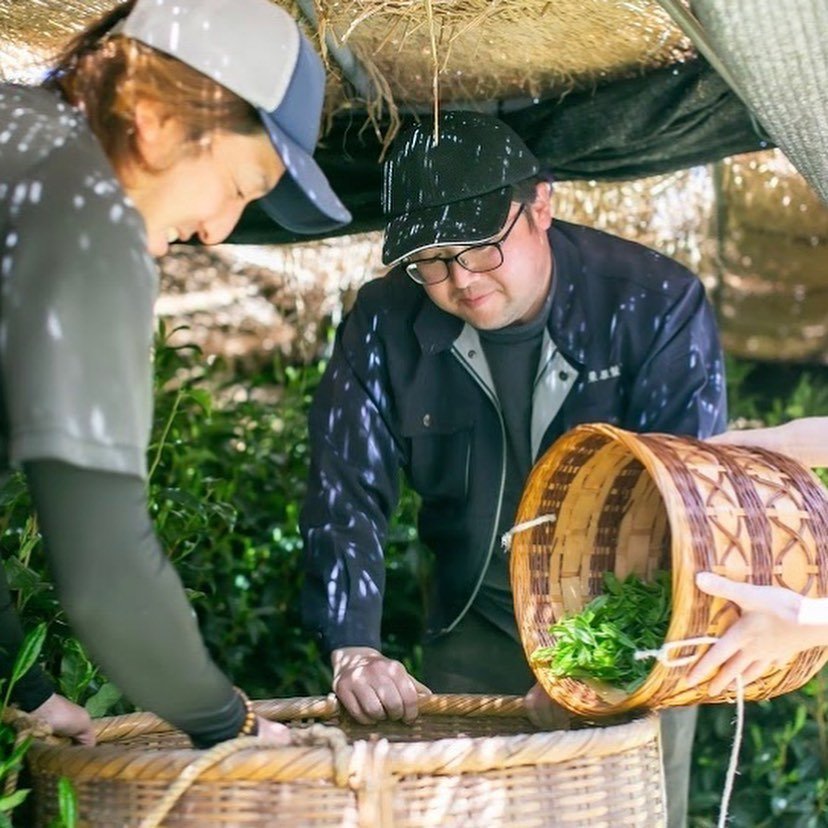こんにちは!元気ですか?
今日は、遮光と遮光茶について深く掘り下げてみたいと思います。玉露、かぶせ茶、抹茶など、お茶を愛飲されている方は、様々な遮光技術で栽培されたお茶をすでに味わったことがあるでしょう。
実は、湯呑茶師のイアン・チュン氏が以前のブログ記事でこの話題に触れています(関連記事: 湯呑みの濃淡はお茶の種類と品質にどのような影響を与えるのか? )。今日は、湯呑みの濃淡が日本茶の世界で一般的になりつつあるこの話題について、もう少し詳しくお話ししたいと思います。
ひふくさいばいとは?
被覆栽培(かぶせこうさいだい)とは、茶の実を収穫前に一定期間、日光を遮ることで茶の木を栽培する方法である。この遮光により、新茶の葉に届く日光を一定量遮断し、茶葉の状態を変化させる。茶業界では「被せ」とも呼ばれ、茶葉を柔らかく、緑が濃く、うま味が増し、苦渋味が抑えられるなど、品質を向上させる栽培方法である。
一般的に、被覆栽培法で栽培されるお茶には、 玉露、かぶせ茶、碾茶などがあります。玉露と碾茶は20日以上遮光して作られ、かぶせ茶は10~14日程度の短い遮光期間で栽培されます。
これらのお茶とは対照的に、「煎茶」は通常、遮光されていない(直射日光の下で栽培された)お茶を指します。しかし、煎茶は、葉を蒸してから揉む(揉まない)緑茶全般を指すとも言えます(したがって、揉まない碾茶は含まれません)。そのため、煎茶は数日間遮光することで品質を少し高めたり、遮光した葉と遮光していない葉をブレンドして品質を高めたり、量を増やしたりすることも可能です。しかし、かぶせ茶や玉露などの銘茶は価格が高いため、玉露を煎茶と名乗る意味はあまりありません。
陰のある歴史
遮光という技術はいつ始まったのでしょうか?遮光は16世紀後半に始まった技術で、当初の目的は、早春の気温が低い時期に、茶葉の新芽を霜害から守ることでした。
しかし、時と経験を積み重ねるにつれ、茶農家は霜よけのために遮光された茶葉の方が品質が良いことに気づき始めました。より緑が濃く、香りと風味も優れていたのです。また、森林に囲まれた(つまり日陰が多い)茶樹や森林地帯で育った茶樹の方が、より高品質な茶葉を生産できることにも気づきました。こうして、遮光は高品質な茶葉を生産するための技術へと発展していきました。
1835年、江戸(東京の旧称)の山本山家6代目当主である若き山本嘉兵衛(やまもとかへい)は、京都宇治の農家兼生産者・木下吉左衛門のもとで碾茶の製法を学ぶため、製茶途中の碾茶の葉を小さな玉に丸めて乾燥させました。彼はそれを江戸に持ち帰り、 「玉の露」(たまのつゆ。後に「玉露」と表記されるようになりました)と名付けました。宇治出身の江口茂十郎が、栽培中に葉に日陰を作ることで玉露の甘みが出ることに気づいたことから、玉露の歴史はここから続いていきます。
なぜシェーディングにこだわるのでしょうか?
植物は水、日光、そして良質な土壌を必要とするという事実を考えると、茶樹に当たる日光量を制限しようとするのは奇妙に思えるかもしれません。しかし、適度なストレス(ユーストレス)が人間のパフォーマンスに良い影響を与えるのと同様に、日光制限などのストレス要因も植物の成長と化学反応に良い影響を与える可能性があります。実際、遮光はお茶の3つの重要な要素、すなわち味、香り、そして色にメリットをもたらします。
味覚:うま味を最大限に引き出す
被覆栽培の最も重要な理由は、おそらく日本茶特有のうま味を得るためでしょう。日本茶のうま味成分であるL-テアニンというアミノ酸について聞いたことがあるかもしれません。
しかし、日光に当たるとテアニンはカテキンに変化し、渋みと苦みが増します。一方、遮光することで葉に含まれるL-テアニンの量が増加し、うま味が最大限に引き出されます。一方、カテキンに比べて爽やかな苦味を持つカフェインは、遮光によってその量が増加します。このように、遮光栽培されたお茶は渋みと苦みが少なく、飲む人はうま味と甘みをより深く感じることができるのです。
独特の青海藻のような香り
茶葉を覆い隠すことで、茶葉には「覆い香り」と呼ばれる青い海藻のような独特の香りが漂います。この香りはジメチルサルファイドという香気成分を作ることで生まれます。ジメチルサルファイドは多すぎると不快な香りにつながりますが、少量であれば他の香気成分と混ざり合い、爽やかで心地よいお茶の香りを作り出します。かぶせ茶は、覆い栽培の証ともいえるこの「覆い香り」は、高品質なお茶を代表する香りであり、その証でもあります。かぶせ茶は玉露や抹茶に比べて覆い隠す期間が短いため、この独特の香りは一般的に弱くなります。
しかし、「覆い香」は茶葉本来の香りや品種特有の特徴を覆い隠してしまう可能性があるため、茶農家が独特の香りや特徴を残したいと考えている場合には適さない場合があります。
美しい色
遮光によってさらに美しくなるもう一つの要素は、茶葉の色です。遮光された茶樹は少ない日光で光合成を行わなければならないため、同じ量の光合成を行うためにより多くのクロロフィルを生成しなければなりません。遮光されていない茶樹と比較してクロロフィルの量が多いため、濃いながらも明るく美しい緑が生い茂ります。さらに、遮光された茶葉はできるだけ多くの日光を浴びようと表面積を増やそうとするため、柔らかく繊細になりやすく、上品で美しいお茶に加工しやすくなります。

栗原茶園の伝統の玉露茶葉は生命力と色彩に輝いています!
シェーディングのやり方:さまざまなシェーディング手法
遮光のメリットについていくつかお話ししましたが、伝統的な方法から現代的な方法まで、遮光に用いられる様々な方法についても触れたいと思います。それぞれの方法の詳細については後ほど詳しく説明しますが、それぞれの方法は基本的に同じです。つまり、高品質なお茶(味、香り、色)を生産し、収穫期間を延ばし、茶樹を霜から守るということです。
伝統的な本酢技法【本簾(ほんず)覆い】ホンズヒフク』
これは天井棚を覆う伝統的な遮光方法ですが、茶樹に直接覆うことはほとんどありません。現在では、この方法は非常に高品質な玉露や碾茶(抹茶に使用)の生産に用いられています。本浸し技法の重要な特徴は、藁、竹、葦などの有機素材を用いて遮光することです。この方法では、茶農家は数日ごとに屋根に素材を追加することで遮光率を徐々に高め、時間の経過とともに遮光率を高めていきます。
 球磨茶園の伝統的な色合い
球磨茶園の伝統的な色合い
例えば、最初の7~10日間は茶畑全体を50%のヨシで覆うことができ(つまり、55~60%の日光が遮られます)、その後、600~700kgの稲わらをヨシの上に均等に敷き詰めます。これにより、約10日間、95~98%の日光が遮られます。Yunomiでは、伝統的な本浸し技術を用いたものを「 ヘリテージグレード」と呼んでいます(例: 栗原茶16号:競技用さえみどりヘリテージ玉露)。
 栗原茶園の春の収穫風景。伝統工芸品の玉露を生産する茶農家は珍しく、伝統的な製法で茶葉を摘む農家もいますが、中には手間のかかる工程を経て、コンテストに出場し、最高品質の茶葉を生産する農家もいます。写真提供:栗原茶園(福岡県八女市、2020年)。
栗原茶園の春の収穫風景。伝統工芸品の玉露を生産する茶農家は珍しく、伝統的な製法で茶葉を摘む農家もいますが、中には手間のかかる工程を経て、コンテストに出場し、最高品質の茶葉を生産する農家もいます。写真提供:栗原茶園(福岡県八女市、2020年)。
藁、竹、葦などで日陰を作ることで、茶樹に理想的な日陰を作ることができます(自然の日陰に覆われた茶樹を目の当たりにできたら、どんなに素晴らしいことでしょう!)。しかし、この伝統的な日陰作りは、茶農家が日陰材を集め、生育期を通して最適な状態を保たなければならないため、大変な労力を要します。そのため、現在ではほとんど行われていません。実際、日本の早春に茶畑を訪れたことがある方は、より一般的な日陰作りに出会ったことがあるかもしれません。それは、茶畑を覆う黒い合成繊維素材です。この黒い合成繊維素材を使った日陰作りは、日本語で「寒冷紗」と呼ばれます。様々な種類の繊維があり、不透明度も様々です。そのため、天然素材を使った本染めでは日陰が不均一になることがあります。しかし、合成繊維を使用することで、茶農家は日陰で育てた茶樹の遮光性をより正確に、均一に、そして効果的に調整することができます。

遮光に使われる黒色の合成繊維素材のクローズアップ。京都府和束町。
黒色の合成繊維素材は、一般的に二重遮光工法、トンネル遮光工法、または直接被覆工法に使用されます。以下では、それぞれの構造について詳しく説明します。
棚型二段被覆 [たながたにだんひふく] は、構造と目的の両方において伝統的な本浸し技法に類似している。第一に、この被覆構造は本浸し技法の簡略版である。金属の棒を棚状に重ねて構築する。第二に、棚型二段被覆は玉露や碾茶の製造に用いられ、同じ構造の上にさらに層を追加することで段階的に光を遮断することができる。有機質資材による被覆では、収穫期ごとに構造物を構築し、解体する必要があるが、棚型二段被覆では、合成繊維を一年中圃場に巻き付けたままにできるため、生産者は季節に応じた温度調節や霜・寒さからの保護など、より柔軟に被覆を使用することができる。
二重遮光法は、従来の方法に比べて維持管理が容易であることは明らかですが、本浸し遮光には数多くの利点があります。ご想像の通り、本浸し遮光では、遮光に用いる天然素材が茶樹の呼吸を促し、風通しを良くします。さらに、茶葉が吸い込む空気中に藁の香り(うーん!)が漂い、お茶の味わいに有機質土壌ならではの独特の風味を加えます。雨が降ると、厚い藁の層を通り抜けた雨粒が藁から蓄えられた養分を運び、日陰で育った茶葉と土壌に届けると考えられています。茶園の覆いに使われた藁自体も、肥料として利用されます。天然遮光は合成繊維素材のように再利用することはできませんが、他の有意義な用途があります。つまり、本来の遮光という役割を終えた麦わらは、茶畑に落とされ、茶樹の間に敷き詰められます。麦わらは茶畑の土壌温度を調節する上で重要な役割を果たし、雑草の生育を抑えます。そして、分解されると土に還り、翌年の芽の栄養源となります(茶草場を思い出しませんか?)。
トンネル遮蔽工法[トンネル被覆;とんねるひふく』
主にかぶせ茶(かぶせ茶)の生産に用いられるこの方法は、直径8~10mmのガラス繊維製の支柱を円弧状に曲げ、その上に合成繊維製の資材を一層だけ敷き詰めることで、樹冠をトンネル状に形成する。この方法により、遮光率は60~75%に達し、かぶせ茶の製造には、収穫直前の10~14日間、この遮光状態を維持することが求められる。
この方法の欠点は、茶農家にとって支柱を立て、さらに支柱の上に遮光板を設置するのにかなりの時間がかかることです。多くの茶農家は直接遮光する方法を好みます。 トンネル遮光法については、こちら(日本語リンク)をご覧ください。
ダイレクトシェーディング法 [直接被覆;チョクセツヒフク』
遮光茶(通常の玉露、かぶせ茶、碾茶、煎茶など)の栽培において、現在最も時間がかからず、最も経済的な遮光方法です。最も一般的な方法であるため、日本の主要な茶産地を訪れたことがある方なら、この遮光方法を目にしたことがあるかもしれません。この遮光方法はトンネル遮光法に似ていますが、より簡略化されており、茶農家は茶樹の上に黒い合成繊維を直接敷くだけです。

福岡県八女市の球磨茶園が直射日光を遮る取り組みを行っている。
 京都府和束町にある喜六茶園の直陰の茶畑(左)。
京都府和束町にある喜六茶園の直陰の茶畑(左)。
抹茶の食用への利用は1980年代頃から始まり、平成時代(1989~2019年)にはアイスクリームや飲料向けの需要が増加しました。日本人だけでなく欧米人にも抹茶が人気を集めていることが、遮光茶の生産量が大幅に増加した大きな要因の一つです。加工用の抹茶は一般的に碾茶の品質が低いため、生産コストを削減するために直接遮光法が採用されています。今後、茶業界では直接遮光法が拡大していくと予想されます。
はい!濃淡と日本茶についての話はこれで終わりです。このテーマについて何か新しい発見ができたことを願っています。何かご質問がありましたら、お気軽にご質問やご意見をお寄せください。濃淡は日本茶栽培の技術の一つです。五感をフル活用して、日本茶の様々な色合いを楽しんでいただければ幸いです。
何か他にご意見やご質問がございましたら、お気軽に下記にコメントやご質問を投稿してください。または、私(Moé Kishida)まで直接ご連絡ください:moe@yunomi.life。ありがとうございます!
この記事は2024年4月18日に更新されました。



2件のコメント
It was a great pleasure to read this article, well detailed information, thank you
Thank you very much for this informative article.